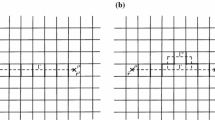Abstract
Building upon Dyson’s fundamental 1962 article known in random-matrix theory as the threefold way, we classify disordered fermion systems with quadratic Hamiltonians by their unitary and antiunitary symmetries. Important physical examples are afforded by noninteracting quasiparticles in disordered metals and superconductors, and by relativistic fermions in random gauge field backgrounds.
The primary data of the classification are a Nambu space of fermionic field operators which carry a representation of some symmetry group. Our approach is to eliminate all of the unitary symmetries from the picture by transferring to an irreducible block of equivariant homomorphisms. After reduction, the block data specifying a linear space of symmetry-compatible Hamiltonians consist of a basic vector space V, a space of endomorphisms in End( ), a bilinear form on
), a bilinear form on  which is either symmetric or alternating, and one or two antiunitary symmetries that may mix V with V*. Every such set of block data is shown to determine an irreducible classical compact symmetric space. Conversely, every irreducible classical compact symmetric space occurs in this way.
which is either symmetric or alternating, and one or two antiunitary symmetries that may mix V with V*. Every such set of block data is shown to determine an irreducible classical compact symmetric space. Conversely, every irreducible classical compact symmetric space occurs in this way.
This proves the correspondence between symmetry classes and symmetric spaces conjectured some time ago.
Similar content being viewed by others
References
Altland, A., Zirnbauer, M.R.: Nonstandard symmetry classes in mesoscopic normal-/superconducting hybrid systems. Phys. Rev. B 55, 1142–1161 (1997)
Altland, A., Simons, B.D., Zirnbauer, M.R.: Theories of low-energy quasiparticle states in disordered d-wave superconductors. Phys. Rep. 359, 283-354 (2002)
Arnold, V.I.: Mathematical methods of classical mechanics. New York, Heidelberg, Berlin: Springer-Verlag, 1978
Bergmann, G.: Weak localization in thin films – a time-of-flight experiment with conduction electrons. Phys. Rep. 107, 1–58 (1984)
Berline, N., Getzler, E., Vergne, M.: Heat kernels and Dirac operators. Berlin, Heidelberg, New York: Springer-Verlag, 1992
Caselle, M., Magnea, U.: Random-matrix theory and symmetric spaces. Phys. Rep. 394, 41–156 (2004)
Dyson, F.J.: The threefold way: algebraic structure of symmetry groups and ensembles in quantum mechanics. J. Math. Phys. 3, 1199–1215 (1962)
Eremin, I., Manske, D., Ovchinnikov, S.G., Annett, J.F.: Unconventional superconductivity and magnetism in Sr2 Ru O4 and related materials. Ann. Physik 13, 149–174 (2004)
Gruzberg, I.A., Ludwig, A.W.W., Read, N.: Exact exponents for the spin quantum Hall transition. Phys. Rev. Lett. 82, 4524–4527 (1999)
Halasz, M.A., Verbaarschot, J.J.M.: Effective Lagrangians and chiral random-matrix theory. Phys. Rev. D 51, 2563–2573 (1995)
Helgason, S.: Differential geometry, Lie groups and symmetric spaces. New York: Academic Press, 1978
Katz, N.M., Sarnak, P.: Random matrices, Frobenius eigenvalues, and monodromy. Providence, R.I.: American Mathematical Society, 1999
Mackenzie, A.P., Maeno, Y.: The superconductivity of Sr2 Ru O4 and the physics of spin-triplet pairing. Rev. Mod. Phys. 75, 657–712 (2003)
Read, N., Green, D.: Paired states of fermions in two dimensions with breaking of parity and time-reversal symmetries and the fractional quantum Hall effect. Phys. Rev. B 61, 10267–10297 (2000)
Senthil, T., Fisher, M.P.A.: Quasiparticle localization in superconductors with spin-orbit scattering. Phys. Rev. B 61, 9690–9698 (2000)
Senthil, T., Marston, J.B., Fisher, M.P.A.: Spin quantum Hall effect in unconventional superconductors. Phys. Rev. B 60, 4245–4254 (1999)
Senthil, T., Fisher, M.P.A., Balents, L., Nayak, C.: Quasiparticle transport and localization in high-T c superconductors. Phys. Rev. Lett. 81, 4704–4707 (1998)
Stewart, G.S.: Heavy-fermion systems. Rev. Mod. Phys. 56, 755–787 (1984)
Tsuei, C.C., Kirtley, J.R.: Pairing symmetry in the cuprate superconductors. Rev. Mod. Phys. 72, 969–1016 (2000)
Verbaarschot, J.J.M.: The spectrum of the QCD Dirac operator and chiral random-matrix theory: the threefold way. Phys. Rev. Lett. 72, 2531–2533 (1994)
Verbaarschot, J.J.M.: The spectrum of the Dirac operator near zero virtuality for N c = 2. Nucl. Phys. B 426, 559–574 (1994)
Verbaarschot, J.J.M., Zahed, I.: Spectral density of the QCD Dirac operator near zero virtuality. Phys. Rev. Lett. 70, 3852–3855 (1993)
Vollhardt, D., Wölfle, P.: The superfluid phases of Helium 3. London: Taylor & Francis, 1990
Zirnbauer, M.R.: Riemannian symmetric superspaces and their origin in random-matrix theory. J. Math. Phys. 37, 4986–5018 (1996)
Author information
Authors and Affiliations
Corresponding author
Additional information
Communicated by P. Sarnak
Rights and permissions
About this article
Cite this article
Heinzner, P., Huckleberry, A. & Zirnbauer, M. Symmetry Classes of Disordered Fermions. Commun. Math. Phys. 257, 725–771 (2005). https://doi.org/10.1007/s00220-005-1330-9
Received:
Accepted:
Published:
Issue Date:
DOI: https://doi.org/10.1007/s00220-005-1330-9



